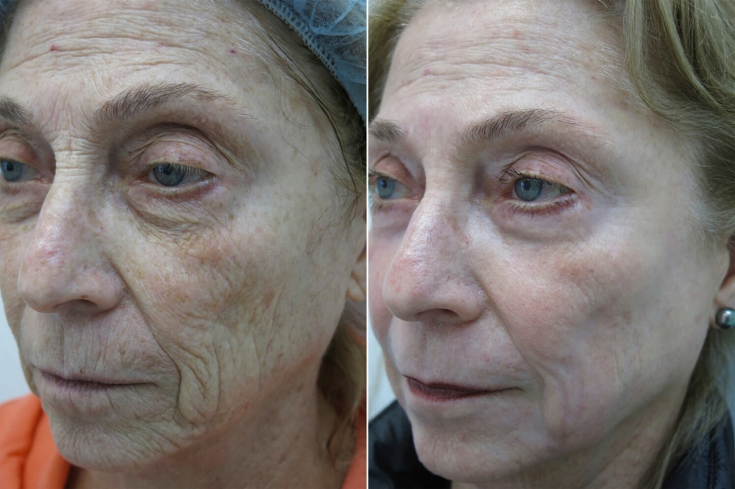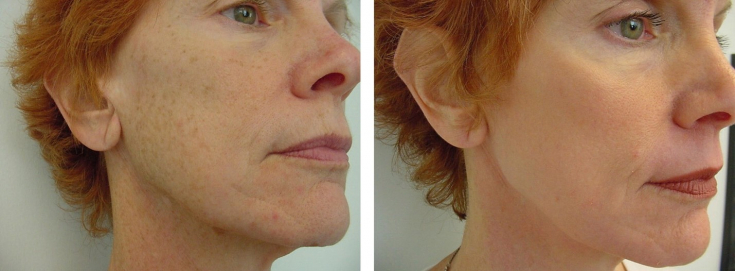Chemical peeling is the process of applying chemicals to the surface of the skin to break down the outer damaged layers, thereby accelerating the normal process of exfoliation followed by the regeneration of new tissues. Each specialist must, first of all, carefully select a peel that most closely matches the patient's skin and indications for treatment. Pre-peel and post-peel stages are also two important stages that determine a successful result and the absence of complications. Let's talk on estet-portal.com about what types of peels exist , what is the degree of penetration for each of them, as well as about acids,
Classification of chemical peels: superficial, medium, deepI. The
superficial peels that remove the stratum corneum (depth = 0.06 mm) include the following:
Follow us on- Glycolic acid, 30 to 50%, applied for 1-2 minutes;
- Jessner's solution, applied in 1-3 coats;
- Resorcinol with low concentration - from 20 to 30%,
- TCA 10% applied in 1 coat.

Superficial
peels that cause epidermal exfoliation of the granular layer up to to the basal layer (depth = 0.45mm) include:
- Glycolic acid, 50 to 70%, applied 2 to 20 minutes;
- Jessner's solution applied in 4-10 coats;
- Resorcinol, 40-50%, applied from 30 to
- TCA, 10 to 30%.
The Anatomy of a Chemical Peel: Acids
II. Middle peels reach papillary dermis (depth = 0.6 mm).
Medium and deep peels: mechanism of action
Peelings of this depth include:
- 70% applied over a period of 3 to 30 minutes;
- TCA , 35 to 50%;
- Extended TCA:
- - Carbon Dioxide + TCA 35%;
- Glycolic acid 70% + 35% TCA.

III.
Deep peels reach the reticular dermis (depth = 0.8 mm) and include: Phenol 88%;
Because peeling withglycolic acid
has a highly variable penetration depth, it is not suitable for deep peels, it is more often used forsuperficial peels in concentrations from 30 to 70%, and sometimes in medium peels at a concentration of 70%. Depth of penetration may vary depending on the pH of the formulation. The lower the pH, the more likely it is that glycolic acid will penetrate deeper and into more sensitive areas.
70% glycolic acid solution pH 2.75 contains 48% free GA. If the pH is 0.6, all of the acid component will be free. A 50% HA solution at pH 1.2 contains 48% free HA. It can be presented as an aqueous solution or as a gel.Follow us on
Facebook! With the help of trichloroacetic acid
(TCA) it is possible to carry out superficial, medium and deep peelsdepending on the concentration: - 10% TCA: superficial peel
- 10-30% TCA: medium depth peel- 35–50% TCA: deep peel
It is not recommended to apply TCA above 50% due to the high risk of scarring.
Lactic acidis also an alpha hydroxy acid like glycolic acid, used in an aqueous alcohol solution
at a concentration of 85%, pH 3.5, with activity similar to glycolic acid . Salicylic Acid
is a beta-hydroxy acid used at 20% or 30% as an alcohol solution, at 40% or 50% as an ointment for use on the upper extremities. The acid has akeratolytic effect and is used for superficial peels.
Complications after chemical peels acid is a dicarboxylic acid that inhibits the activity of neutrophils, reduces the formation offree radicals and serves as their scavenger. Thus, it has the anti-age properties. Although it is rarely used in peels, the required concentration is 20%. When using
phenol at 88%it penetrates the reticular dermis, coagulates the keratin and prevents it from penetrating to deeper levels. Baker-Gordon Formula - more widely known and used in peels. The formula is : phenol: 88% phenol + 12% water (3 ml)
- regular or distilled water (2 ml)
- soap - liquid hexachlorophene (0.025%, 8 drops)
- croton oil: (3 drops).

surfactant
(detergent), it acts as a conductor and reduces the surface tension of the oil present in the skin, removing it by emulsification, thus providingeven exfoliation .
Phenol peeling: application featuresPhenol is systemically absorbed and can cause cardiotoxicity, nephrotoxicity, hepatotoxicity, and central nervous system depression.
This is a very painful peeling due to the effect of phenol on the reticular dermis, which requires the use of sedatives and analgesics
, as well as dynamic monitoringduring and after the procedure. Chemical peel
is an essential tool for every cosmetic doctor for the purpose of controlled damage and skin renewal according to indications. They allow you to act on the superficial, middle and deeper layers of the skin. A competent choice of peeling individually for each patient allows you to get a high-quality result and reduces the risk of complications.More interesting stuff is waiting for you on our
YouTube channel:







Add a comment